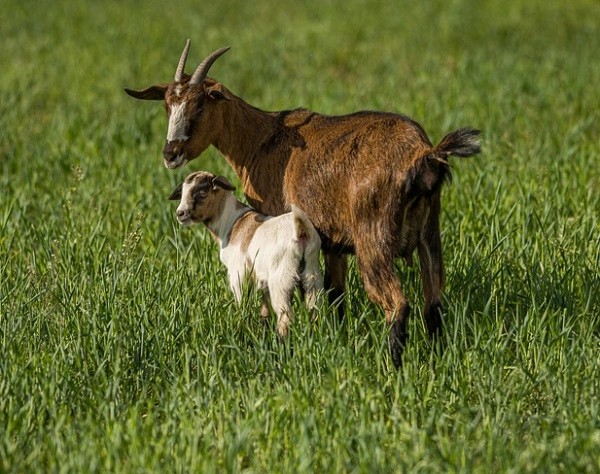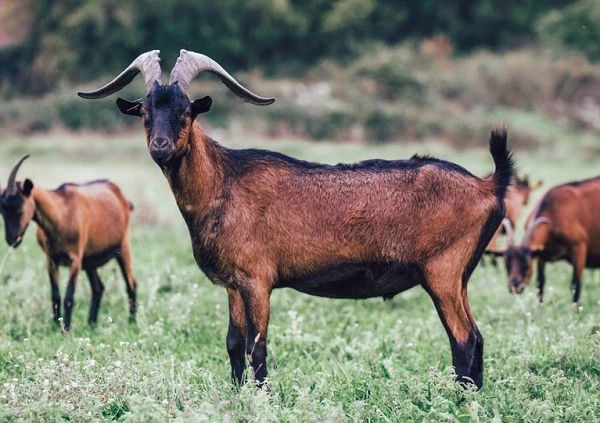Alpine goats are a hardy breed of goat that is well-suited to colder climates. They are known for their thick coats of hair, which helps keep them warm in the winter. Alpine goats are also productive milkers, and their milk has a high butterfat content. This makes it ideal for making cheese and other dairy products. If you’re interested in raising Alpine goats, there are some things you need to know before you get started. In this article, we’ll discuss the care and feeding of these animals, as well as some common health problems they may encounter. We’ll also provide tips on how to choose an Alpine buck or doe, and give you an idea of what it costs to raise these goats. So if you’re thinking about adding Alpine goats to your herd, read on!

Alpine Goat Description
Alpine goats are a type of domestic goat that is used for milk production. Alpine goats are characterized by their large size, strong build, and black and white markings. Alpine goats originated in the Alps, a mountain range in Europe, and they get their name from this region. Alpine goats are widely considered to be one of the best milk-producing goats, and they are often used in dairy farms. Alpine goats are also known for their hardiness, and they can survive in harsh conditions that would kill other animals. Thanks to these qualities, Alpine goats have been imported all over the world and can now be found in many different countries.
Alpine Goat Habitat
Alpine goats are a hardy breed of goat that is well-suited to life in the mountains. They are native to the Alpine regions of Europe, and their thick fur coats help to keep them warm in even the coldest temperatures. Alpine goats are also very sure-footed, thanks to their cloven hooves, which help them to grip onto steep and rocky terrain. Alpine goats are typically gentle and docile creatures, but they can also be very curious and playful. In the wild, Alpine goats live in herds of around 10-15 individuals. These herds usually contain more females than males, as males will leave the herd once they reach sexual maturity. Alpine goats are primarily herbivores, and their diet consists mostly of grasses, herbs, and leaves. Occasionally, they will also eat small amounts of mosses or lichens. Alpine goats are most active during the day, but they will often rest for long periods during bad weather. Although Alpine goats are not currently endangered, their populations have declined in recent years due to hunting and habitat loss.
Alpine Goat Diet
Alpine goats are a type of domestic goat that is used for milk production. They are native to the Alpine region of Europe, and their diet consists mostly of grasses and other plants. Alpine goats are also known to eat some insects, especially in the summer months. In addition to their diet of plants and insects, Alpine goats also consume significant amounts of water. This is necessary to maintain their body temperature in the Alpine environment, where temperatures can vary significantly from day to night. Alpine goats are well adapted to their diet and environment, and they are an important source of milk for many people in the Alpine region.
Alpine Goat Size
Alpine goats are a type of domesticated goat that is known for its hardy nature and ability to thrive in Alpine conditions. Alpine goats are medium-sized animals, with an average weight of between 120 and 150 pounds. They have long, lustrous coats that can be either black, brown, or white in color. Alpine goats are also known for their strong and muscular build, which enables them to climb steep slopes and maneuver through rugged terrain. Alpine goats are intelligent creatures that are easy to train and make excellent companion animals. In addition to their size and hardy build, Alpine goats also have a reputation for being very lovable and affectionate creatures.

Alpine Goat Lifespan
Alpine goats are a type of domestic goat that is known for its hardiness and ability to thrive in cold, mountainous regions. Alpine goats are medium-sized animals, with males typically weighing between 150 and 200 pounds and females averaging between 120 and 150 pounds. Alpine goats generally have a lifespan of 12 to 14 years, although some individuals have been known to live for up to 20 years. Alpine goats are well-adapted to their natural environment, with thick fur coats that protect them from the cold and horns that help them to navigate snowy terrain. Alpine goats are also very social animals, living in herds of 10 to 15 individuals. Alpine goats are an important source of milk, meat, and fiber for many rural communities around the world.
Alpine Goat Behavior
Alpine goats are a hardy breed of goat that is well-suited to life in the mountains. They are known for their sure-footedness and their ability to climb steep slopes. Alpine goats are also very curious and social animals. They will often approach humans in order to investigate them, and they enjoy company. Alpine goats are generally calm animals, although they can be stubborn at times. They are also very intelligent, and they are quick learners. Alpine goats make excellent companion animals, and they can be trained to perform a variety of tricks.
Alpine Goat Speed
Alpine goats are a type of domestic goat that is typically kept for milk production. Alpine goats are also known for their fast speed, which often allows them to outrun predators. Alpine goats can run up to 30 miles per hour, and they are often used in racing events. Alpine goats are also popular as pets, and they are known for their friendly nature. Alpine goats are usually white or black in color, and they have long horns that curve upwards. Alpine goats require a lot of space to roam, and they typically live in mountainous regions. Alpine goats are an important part of many cultures, and they have been domesticated for thousands of years.
Alpine Goat Hunting
Alpine Goat hunting is a challenging and rewarding experience. These animals are sure-footed and agile, making them difficult to take down. However, hunters who are prepared for the challenge can reap the benefits of Alpine Goat meat, which is lean and nutritious. In addition, Alpine Goat hunting can provide an opportunity to enjoy the beauty of the Alpine mountain range. With its majestic peaks and pristine forests, the Alpine setting is truly unforgettable. For those who relish a challenge, Alpine Goat hunting is the perfect way to experience all that the Alps have to offer.
Conclusion
Alpine Goats are one of the oldest domesticated animals in the world. They have been used for their milk, meat, and hides for centuries. Today, they remain an important part of many agricultural economies around the globe. Alpine Goats are also popular pets and can be easily trained to lead caravans or pull carts. What do you think? Are Alpine Goats a good fit for your farm or homestead?
Frequently Asked Question

